Review of the Leader septic tank: design, principle of operation, advantages and disadvantages
When installing an autonomous sewer system, local treatment points are used, which collect and process household wastewater.If you are interested in purchasing a fully equipped factory system, pay attention to the domestic septic tank “Leader”, which operates on the principle of four-stage cleaning.
The article we presented describes the principle of operation of an installation that produces a deep degree of purification of household wastewater. We introduce the most popular models of this brand. Do-it-yourselfers will find installation manuals and useful operating tips here.
The content of the article:
- Description of the VOC design from Leader
- Operating principle of an autonomous system
- How to choose the right model?
- Advantages and disadvantages of Leader brand structures
- Recommendations for installation and maintenance
- Current cost of septic tanks and service prices
- Conclusions and useful video on the topic
Description of the VOC design from Leader
The compact but roomy design is a container, the inside of which is divided into several compartments. The volume of the internal chambers, respectively, and the dimensions of the tank as a whole depend on the amount of incoming waste.
The material used is low-density polyethylene, which is wear-resistant and resistant to high and low temperatures. Polymer walls are also good because they can withstand soil pressure, do not rust or become moldy.
When purchasing one of the Leader models for arrangement independent sewerage you will receive the following kit:
- frame;
- compressor made in Japan (HIBLOW);
- two types of crushed stone for backfilling: lime and granite;
- a set of polymer brushes;
- instructions and warranty card.
There are two versions of the Leader LOS: both consist of several functional compartments for various purposes.The first modification is intended for the gravity drainage method.
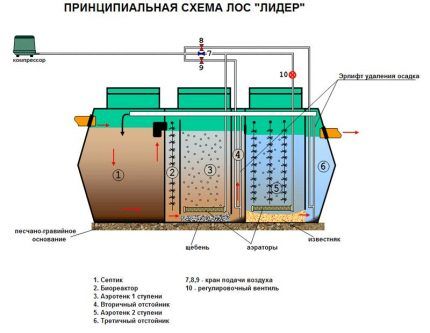
The second variety is called “Leader n”, as it is additionally equipped with a drainage pump.
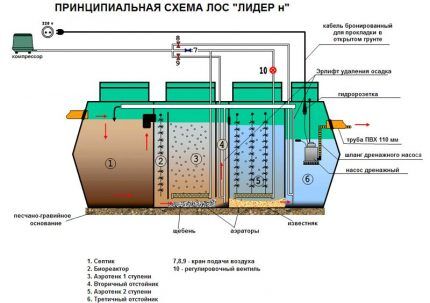
Inside, the structure is divided into 6 technological containers, each of which has its own purpose:
- 1 – septic tank receiving sewage; primary fermentation and separation of waste occurs in it;
- 2 – bioreactor with artificial algae, facilitating the oxidation of substances by anaerobes;
- 3 – 1st stage aeration tank, in which waste decomposition continues, but with the help of aerobes;
- 4 – secondary settling tank separating clarified wastewater and activated sludge;
- 5 – stage 2 aeration tank, in which further oxidation and neutralization of phosphates occurs;
- 6 – tertiary settling tank for sediment separation.
The first settling tank is not equipped with equipment; the remaining ones are equipped with additional parts and filled with filler. Artificial algae is loaded into the bioreactor and deep cleaning chamber.
Aero tanks are equipped with perforated aerators and loadings, granite and limestone. In the settling tanks, except for the first one, airlifts are installed for pumping sludge.
In the last chamber of the “Leader N” models there is a drainage pump, with the help of which treated wastewater is pumped out to its intended purpose - into an absorption well, into a pond or a drain.
Operating principle of an autonomous system
Biological treatment is a multi-stage process that is carried out by microorganisms, aerobes and anaerobes. To make processing more efficient, at the first stage, in the settling tank, mechanical separation of particles occurs.
Solid insoluble elements fall to the bottom in the form of sediment, fat floats to the surface, as a result of which the liquid is partially clarified. This is where the fermentation of wastewater begins.
In the next compartment - the bioreactor - fermentation takes on the active phase. The chamber is filled with artificial algae, which are products made from brush-type polymer fishing line.
Anaerobes, which do not require oxygen to function, form colonies on algae. By processing incoming wastewater, they facilitate the oxidation process.
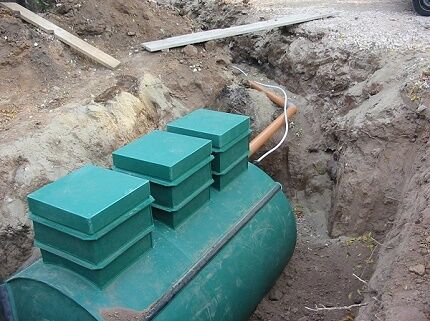
The third chamber is intended for further clarification of the liquid. Oxygen entering the compartment through perforated polymer tubes and aerobic bacteria multiplying on the porous load (gravel backfill) in the form of activated sludge continue to oxidize and process organic matter.
Next, the wastewater is separated: the clarified water flows further to the next purification stage, and excess sludge is removed using an airlift.
The next chamber, an aerobic bioreactor with polymer loading, performs post-treatment of partially clarified wastewater. At the same time, phosphates are neutralized - for this, crushed limestone is placed at the bottom of the compartment, creating an alkaline environment.
The sediment formed during the cleaning process is also removed using an airlift. From the last chamber, the purified liquid is discharged outside, either by gravity or by force (by pump).

As solid sediment accumulates in the sump, vacuum cleaners are called in; the rest of the technological work can be carried out on your own.
How to choose the right model?
When choosing a biorefinery station, it is necessary to take into account many factors, from the possibility of connecting to a power supply to the technical characteristics of the device (performance, volume, etc.). To avoid mistakes, it is better to consult with a consultant - a specialist from the manufacturer who will recommend a suitable model.
Overview of the LOS Leader model range
Knowing the technical characteristics of the septic tank and the number of people permanently residing in the house, you can choose an installation that is suitable for performance. The dimensions of the device directly depend on the performance: the higher it is, the larger the dimensions. As productivity increases, weight also increases, but the weight of models with a pump is always greater than without it.
There are 28 models in total. When marking them, the presence of a pump and the volume of salvo discharge were taken into account. For example, if the salvo discharge is 600 liters, the model is called “Leader-0.6”; a similar device equipped with a pump is called “Leader-0.6n”.
The most compact versions are “Leader-0.4” and “Leader-0.4n”. They are designed for a salvo discharge of 400 liters and have a capacity of 0.2 to 0.5 m3/day.Considering that one person consumes approximately 200 l/day, the smallest model is suitable for houses with 1-2 permanent residents.
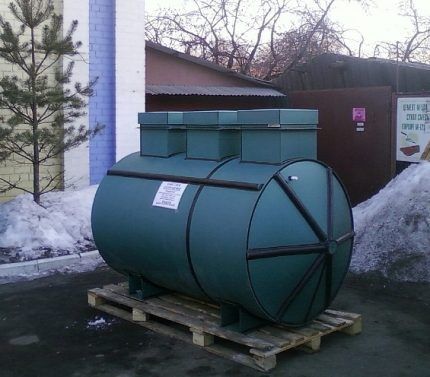
The most voluminous model of household devices, that is, intended for private use, is “Leader-3” (“Leader-3n”). Judging by the performance (from 2 to 3.6 m3/day), it is capable of serving a group of people of 10-15 people.
Power is tied to performance compressorsupplying air to the aerators. For models “Leader-0.4...1” a compressor with a power of 40 W is intended, modifications 1.5 - 60 W, etc.
The diameter and height of the case have slight differences in size, the main difference concerns the length. This should be taken into account when constructing a pit.
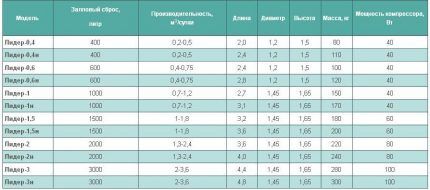
For hotels, inns, and sports centers, more powerful modifications are provided - up to the Leader-25 (Leader-25n) model.
Connection and drainage diagrams
When choosing a scheme for discharging treated water, one of the main factors is the availability of a reservoir for disposal of processed wastewater. The role of such a reservoir can be played by a ditch, drainage ditch, or pond.
If it is possible to lay pipes at an angle (0.02 m/m), it is rational to use the gravity method, in which wastewater flows into the septic tank without the help of additional equipment, and from the septic tank into the ditch.
However, two more conditions must be met:
- the reservoir must be located near the VOC;
- the sewerage pipe must exit the building at least 0.3 m from the ground surface.
The gravity method of moving wastewater is used without connecting additional electrical equipment, therefore, it is economical.
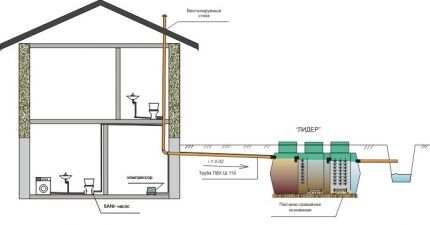
The following drainage scheme differs from the first only in the final drainage point: instead of a ditch or pond, it is used absorption well.
It may be required if:
- a ditch (ditch, pond) is absent or located far away;
- the suburban area is located in a nature protection zone;
- neighbors do not give consent;
- There are other reasons why open dumping is not desirable.
The absorption well will function properly in sandy soils with high filtering capacity.
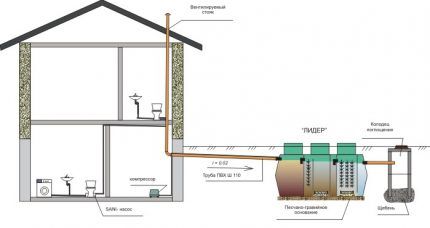
If the reservoir intended for draining wastewater is too shallow (its bottom is higher than the drain pipe) or is located at a far distance, it is rational to use a pump drainage system. The last chamber is installed drainage pump, which provides forced movement of liquid.

You may encounter a connection problem if the sewerage system is present in the basement or basement, but there is no possibility of gravity drainage, that is, the pipe leaves the house too low in the ground (less than half a meter from the surface).
In this case, you will have to equip a so-called sewage pumping station in front of the septic tank - a separate well equipped fecal pump. KNS is purchased separately.
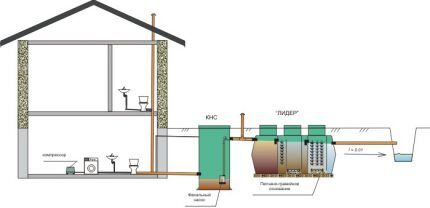
Connecting the installation and drainage require a professional approach, so consultation or control by a representative of the company that carried out the installation supervision will not hurt.
Advantages and disadvantages of Leader brand structures
One of the advantages that Leader brand devices have concerns the location of the structure relative to a residential building. Due to the absence of an unpleasant odor and the quiet operation of the equipment, the septic tank can be placed at a minimum permissible distance of 5 m (SNiP).
Other standards should be taken into account, for example, to the nearest well - 25-30 m for non-cohesive sandy (gravel, crushed stone) soils, 45-50 m for cohesive soils, i.e. clayey rocks (loam, sandy loam).
Residents of cottages who have been using septic tanks for several years note the following advantages:
- high efficiency of sewage treatment - several processing chambers are capable of purifying liquid by 95%;
- the ability to work without biologically active additives, which experts from some companies recommend adding to septic tanks;
- stable operation even with regular long interruptions in the supply of wastewater, which does not require conservation;
- easy tolerability of power outages - in the event of force majeure, the system is able to operate as usual for 2 weeks, without changing the properties of purified water;
- the possibility of using one of the drainage schemes with a focus on the type of reservoir or the presence of a structure for discharging purified liquid;
- compactness of the structure, allowing for economical distribution of the free territory of the site;
- the possibility of installation in clayey soil or in an area with high groundwater without a specially designed concrete foundation (the presence of a stable concrete slab at the bottom of the pit is one of the conditions for installing septic tanks from competitors).
The manufacturer recommends selecting a structure so that the useful volume of the device is approximately 3 times greater than the daily amount of sewage. Many consider this a disadvantage; in fact, this ratio helps to easily withstand salvo discharges and clean the liquid by at least 95%.
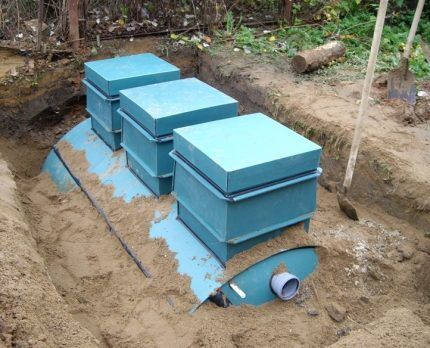
Another advantage can be found by purchasing the Leader cleaning system directly from the manufacturer. Without markups, the cost of equipment that belongs to the middle price segment is much lower.
One of the disadvantages is the poor functioning of the installation at low temperatures and the need for additional insulation, but this problem applies to any VOCs.
Some users report a bad odor, but this is most likely due to incorrect installation or untimely removal of sediment or sludge. Based on reviews, one can judge that the advantages of the Leader septic tank outweigh its disadvantages.
Recommendations for installation and maintenance
It is better to dig the pit for installation away from the roads to protect the septic tank from accidental collision. The case is a single reservoir, so even a small breakdown or leakage can lead to a complete replacement of the device.
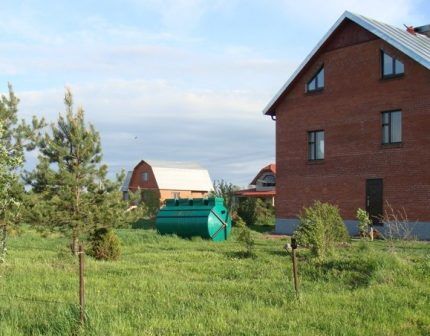
In addition to the basic rules for installing a septic tank in a pit, you need to know a few more engineering nuances:
- for external sewerage it is necessary to use polymer pipes with Ø 100-110 mm;
- supply pipeline slope - 0.02 m per meter of length;
- the slope of the outlet pipeline is 0.05 m per meter of length (should not be too long);
- the base of the pit is filled with sand or sand-gravel mixture and carefully compacted (concreting or installation of a concrete slab is not necessary);
- the liquid inside the housing must reach the level of the weirs;
- Insulated hatches intended for maintenance must be kept closed.
A few notes regarding compressor installation. In winter, it must be located in a heated room (basement, utility room), for ease of maintenance - near the sewer outlet. The device will require a power point to operate.
When the sediment removal procedure occurs, the compressor should be turned off.
During operation of the septic tank, ensure that the performance corresponds to the nominal value. If it exceeds the declared figures by 20%, you should think about replacing the installation with a more powerful one. When using a biological station, it is necessary to review the range of detergents and cleaning products: they should not contain petroleum products or chlorine.
The owner of the Leader septic tank can perform the main part of the maintenance independently. Once every three years you will have to replenish the lime filling in the 2nd aeration tank, and at the same frequency you will have to clean the walls of the housing and spillways.
The polymer brush load should be washed annually, and excess activated sludge should be pumped into the first compartment (receiving chamber) using airlifts. The sludge is removed as it accumulates, approximately every 3-6 months. Once a year, the help of sewer trucks will be required to remove accumulated sediment.
If seasonal operation of a Leader brand treatment plant is planned, then it will be necessary preserve for the winter. Find out what it is in our recommended article.
Current cost of septic tanks and service prices
The price of the kit, which includes the case and the necessary equipment, differs when purchased in different regions. For example, as of February 2017, “Leader-0.4” in Moscow costs 76 thousand rubles, the same model in St. Petersburg costs 5 thousand rubles. more expensive - 81 thousand rubles. The cost of modification with a pump is even higher.
Price list with Moscow prices:
For comparison, prices in St. Petersburg:
Cost of CNS:
To save money, it is better to purchase from an official dealer rather than from an intermediary.
In addition to purchasing a septic tank, you can use the services of consultants. For example, an on-site consultation with drawing up a connection diagram and estimate will cost 1 thousand rubles. (on weekends – 2 thousand rubles).
You can also order the installation of the station - this will be about 30% of the purchase price (without excavation work - 20%). Annual service package – 12 thousand rubles.
Conclusions and useful video on the topic
Several video clips will give you an idea of what a biological treatment plant looks and functions like.
Video #1: How the installation works:

Video #2. A video giving an idea of the quality of sewage treatment:

Video #3. Quality control of cleaning during the cold winter period:

As you can see, the Leader septic tank has decent technical characteristics for effective use in autonomous conditions. To ensure that the quality of the wastewater meets the stated parameters, we recommend operating the installation according to the instructions.
Tell us about your own experience in constructing an independent sewer system with a Leader brand treatment plant or a similar installation. It is possible that you have information that will be useful to site visitors. Please write comments, ask questions and post photos in the block form below.


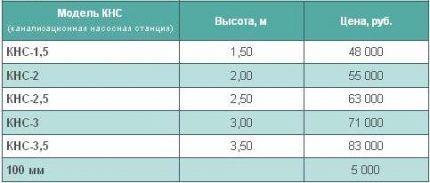




An excellent, unpretentious treatment facility, no dirt, no smell. I pump it out once a year.
Is it suitable for Siberia? Do you need additional insulation? Or is it better to take another model for our region?
It depends on how deep the septic tank will be in the ground. If you plan to go deeper by 1.5-2 meters, then you will not need additional insulation of the septic tank. If the septic tank is located very close to the surface, then the optimal solution would be to insulate it with penoplex. I believe that penoplex is the optimal insulation in this case, based on its characteristics and ease of installation.
In winter, it is necessary to move the compressor from the septic tank to a warm room so that the system operates without interruption. Also, do not forget to insulate the pipes leading to the septic tank; in this case, it is better to use polystyrene foam; there are special insulation materials for the shape of the pipes.